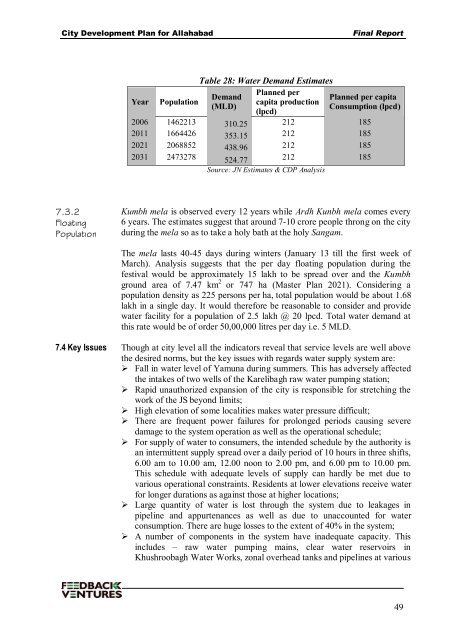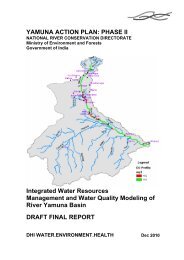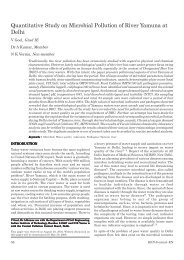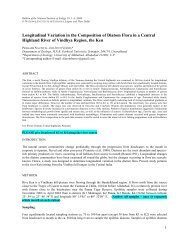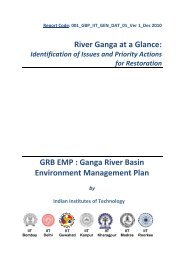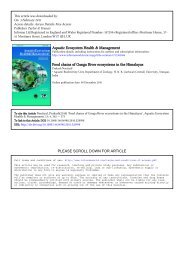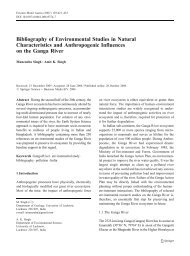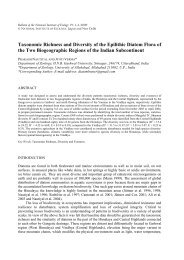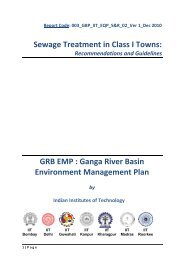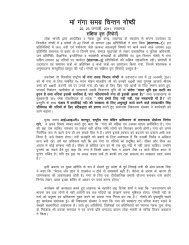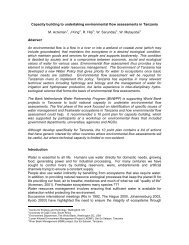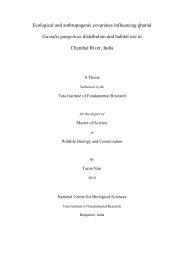Contents - GANGAPEDIA
Contents - GANGAPEDIA
Contents - GANGAPEDIA
Create successful ePaper yourself
Turn your PDF publications into a flip-book with our unique Google optimized e-Paper software.
City Development Plan for Allahabad Final Report<br />
7.3.2<br />
Floating<br />
Population<br />
Year Population Demand<br />
(MLD)<br />
Table 28: Water Demand Estimates<br />
Planned per<br />
capita production<br />
(lpcd)<br />
Planned per capita<br />
Consumption (lpcd)<br />
2006 1462213 310.25 212 185<br />
2011 1664426 353.15 212 185<br />
2021 2068852 438.96 212 185<br />
2031 2473278 524.77 212 185<br />
Source: JN Estimates & CDP Analysis<br />
Kumbh mela is observed every 12 years while Ardh Kunbh mela comes every<br />
6 years. The estimates suggest that around 7-10 crore people throng on the city<br />
during the mela so as to take a holy bath at the holy Sangam.<br />
The mela lasts 40-45 days during winters (January 13 till the first week of<br />
March). Analysis suggests that the per day floating population during the<br />
festival would be approximately 15 lakh to be spread over and the Kumbh<br />
ground area of 7.47 km 2 or 747 ha (Master Plan 2021). Considering a<br />
population density as 225 persons per ha, total population would be about 1.68<br />
lakh in a single day. It would therefore be reasonable to consider and provide<br />
water facility for a population of 2.5 lakh @ 20 lpcd. Total water demand at<br />
this rate would be of order 50,00,000 litres per day i.e. 5 MLD.<br />
7.4 Key Issues Though at city level all the indicators reveal that service levels are well above<br />
the desired norms, but the key issues with regards water supply system are:<br />
Fall in water level of Yamuna during summers. This has adversely affected<br />
the intakes of two wells of the Karelibagh raw water pumping station;<br />
Rapid unauthorized expansion of the city is responsible for stretching the<br />
work of the JS beyond limits;<br />
High elevation of some localities makes water pressure difficult;<br />
There are frequent power failures for prolonged periods causing severe<br />
damage to the system operation as well as the operational schedule;<br />
For supply of water to consumers, the intended schedule by the authority is<br />
an intermittent supply spread over a daily period of 10 hours in three shifts,<br />
6.00 am to 10.00 am, 12.00 noon to 2.00 pm, and 6.00 pm to 10.00 pm.<br />
This schedule with adequate levels of supply can hardly be met due to<br />
various operational constraints. Residents at lower elevations receive water<br />
for longer durations as against those at higher locations;<br />
Large quantity of water is lost through the system due to leakages in<br />
pipeline and appurtenances as well as due to unaccounted for water<br />
consumption. There are huge losses to the extent of 40% in the system;<br />
A number of components in the system have inadequate capacity. This<br />
includes – raw water pumping mains, clear water reservoirs in<br />
Khushroobagh Water Works, zonal overhead tanks and pipelines at various<br />
49


